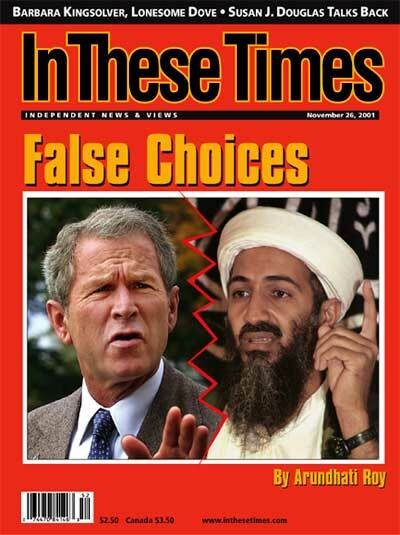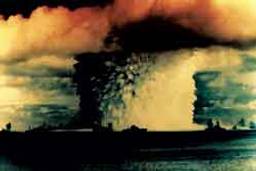Trigger Happy
Bush administration hawks want to deploy ” mini-nukes” against Osama bin Laden
Jeffrey St. Clair
How should the Pentagon get Osama bin Laden? With a discreetly placed nuke,
says Rep. Steven Buyer, the right-wing congressman from northern Indiana. Dont
send special forces in there to sweep, Buyer told an Indianapolis TV station.
Wed be very naive to believe that biotoxins and chemical agents
were not in these caves. Put a tactical nuclear device in and close these caves
for a thousand years.
Buyer doesnt just want to kill bin Laden and his Taliban cohort. He wants
to send a message to the world that America is now willing to use nuclear weapons
on the battlefield. I just want the [Bush] administration to know that
I think the United States needs to send a message to the world that we are prepared
to do that, he says.
During his campaigns, Buyer has relentlessly pushed his service as a Gulf War
vet. He touts himself as an expert on asymmetrical warfare, Pentagon-speak
for attacks waged on U.S. targets by terrorists using unconventional weapons.
Buyer wants to smoke them out with radioactive weapons.
Admittedly, Buyer is one of the kookier members of Congress. But he is far
from a lone voice. A day after the World Trade Center attacks, Sen. Robert Torricelli,
the New Jersey Democrat, vowed that the United States would unleash hell
upon them. And Buyers view was echoed by Rep. Peter King, a New
York Republican, in a radio interview on October 21. I would never rule
out tactical nuclear weapons if I thought they could do the job, and if they
were needed, King told WABC. If the military people said we think
certain chemical weapons are going to be used, we know where they are, and the
only way we can stop their use is by using tactical nuclear weapons.
Among the wizards of Armageddon, there is an almost palpable desire to see
nuclear weapons put to use on the battlefield. The frail doctrine of Mutually
Assured Destruction has been jettisoned with the wreckage of the Soviet Union,
and in its place nuclear war planners are pushing a more robust and offensive
role for the U.S. nuclear stockpile. Two weeks after September 11, the Japan
Times reported that Pentagon war planners had presented Secretary of Defense
Donald Rumsfeld and President Bush with a scenario for the use of tactical nuclear
weapons in Afghanistan. The Tokyo newspaper quoted a Pentagon source, who said
that Bush had rejected the option, fearing almost certain global backlash.
However, Rumsfeld was more circumspect when he was asked directly on ABCs
This Week whether the United States was considering the use of nuclear
weapons against al-Qaeda and the Taliban. We ought to be very proud of
the record of humanity, that we have not used those weapons for 55 years, he told Sam Donaldson. And we have to find as many ways as possible to
deal with this serious problem of terrorism.
But Rumsfelds cagey response was actually a significant statement that
may signal a chilling shift in U.S. policy. Since the mid-70s, the official
U.S. line has been that it will not use nuclear weapons against non-nuclear
nations. Rumsfelds deputy, the hyper-hawkish Paul Wolfowitz, has warned
the Taliban that the United States will use a very large hammer.
In case the Taliban had trouble reading between the lines, Thomas Woodrow,
a Wolfowitz pal and veteran of the Defense Intelligence Agency, made the point
clear in a column for the Washington Times. At a bare minimum,
tactical nuclear capabilities should be used against the bin Laden camps in
the desert of Afghanistan, Woodrow wrote. To do less would be rightly
seen by the poisoned minds that orchestrated these attacks as cowardice on the
part of the United States and the current administration.
The bomb of choice seems to be low-yield nuclear weapons, the so-called bunker-buster
nukes that could be used as a kind of radioactive assassination weapon, designed
to knock out the leadership of hostile regimes. In this twisted logic, proponents
are pushing the bomb as a humanitarian device that could save civilian lives.
Weve seen examples as recently as the air war with Serbia, when
we attacked underground targets with conventional weapons with very little effect, said Paul Robinson, director of the Sandia National Laboratory, in a September
interview with the National Journal. It just takes far too many
aircraft sorties and conventional weapons to give you any confidence that you
can take out underground bunkers. By putting a nuclear warhead on one of those
weapons instead of high explosives, you would multiply the explosive power by
a factor of more than a million.
Theres another reason the nuclear hawks are pushing the idea of shifting
the U.S. nuclear arsenal toward the low-yield nukes: They can develop new weapons
without (in their minds, at least) violating the non-proliferation treaty. We
would neither have to conduct testing nor redesign for such a weapon, because
we have them already, Robinson said. We could develop these lower-yield
weapons without forcing the nuclear testing issue back onto the table, with
a richer database of past tests, and at relatively low cost.
It seems very unlikely that the United States would use nuclear weapons against the Taliban. However, the nuclear hawks and their allies in the bomb-making industries seem to have succeeded in exploiting the war in an effort to breathe life (and billions of dollars) a new generation of nuclear weaponry.






